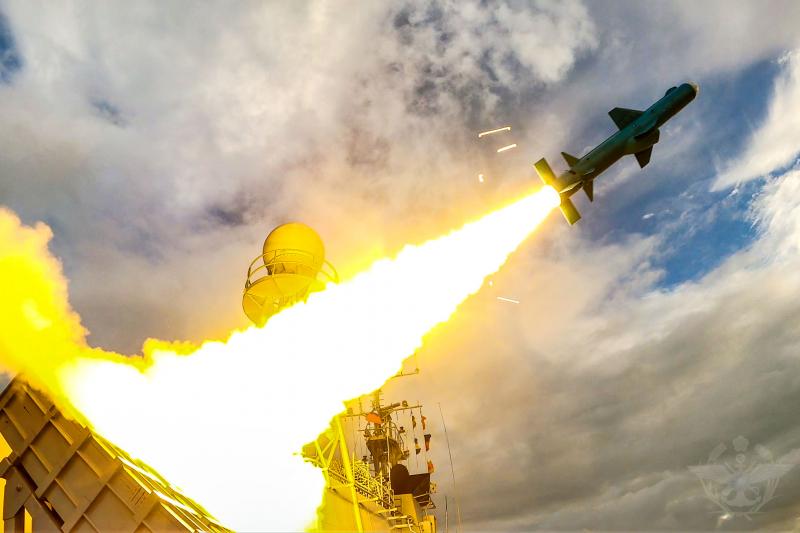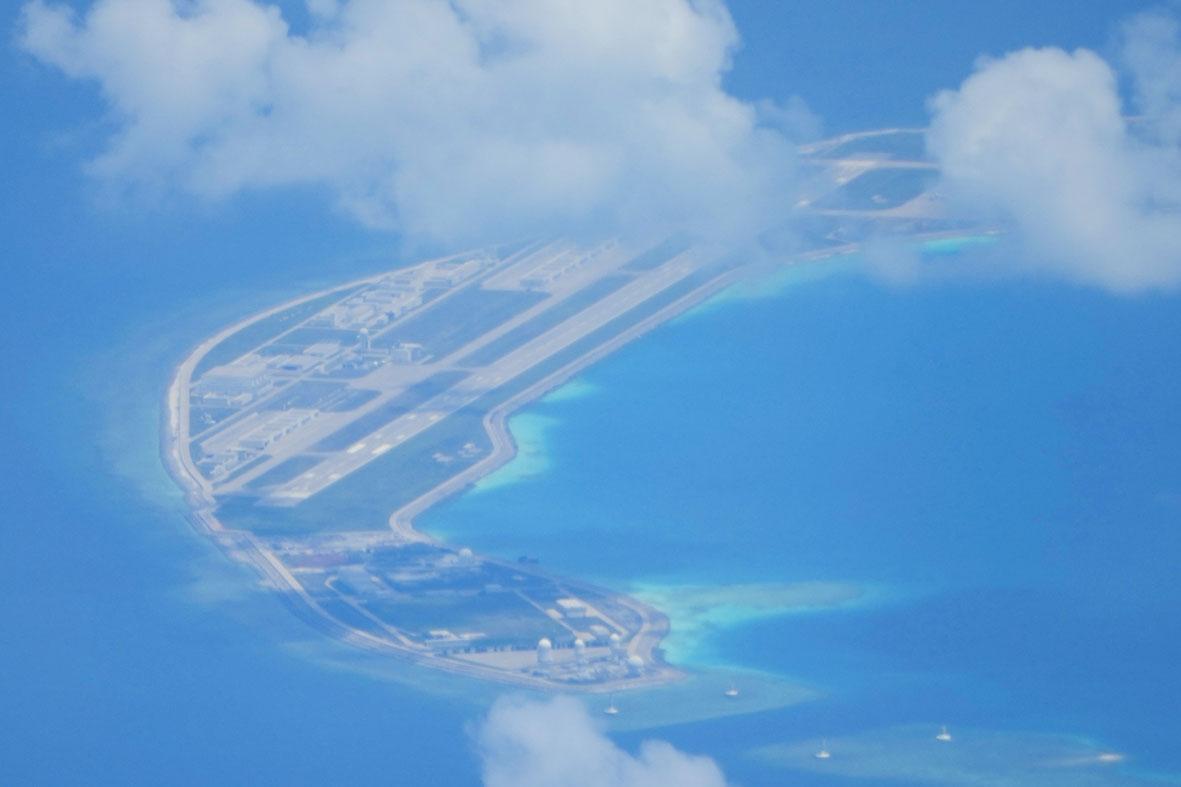This month it was revealed that China has been telling US officials that the Taiwan Strait is not an international waterway, but China’s territorial waters.
“China has sovereignty, sovereign rights and jurisdiction over the Taiwan Straits,” the Global Times thundered last week.
The slow, inexorable expansion of China’s territorial claims by land and sea signals that once Taiwan is annexed, this problem of Chinese expansionism will only become more dire. As a solid explainer from The Interpreter observed last year, China treats “territorial waters” as sovereign waters: “China’s interpretation of the territorial sea is that the state has the exclusive right to make, apply and execute its own laws in that space without foreign interference.”

Photo: EPA-EFE
POTENTIAL CONFLICTS
A glance at any of the many maps of Exclusive Economic Zones (EEZs) claimed by China shows the potential conflicts once Taiwan is obtained. To the east, a string of Japanese islands would punch holes in China’s EEZ, automatically creating further friction between those two nations.
The Japanese themselves are well aware of that possibility. Of the Yaeyama Islands, Yonaguni island is closest to Taiwan. It has its own language, Dunan Munui, and boasts a long history of links to Taiwan (killed when the US shut down black market links early in the postwar era). Currently Japanese, it was once part of the Ryukyu Kingdom’s trading networks.

Photo: AP
In the 19th century, Japan actually offered the Yaeyama islands to the Qing Dynasty as part of a trade deal for access to China’s interior. That fell through and Tokyo eventually solidified its control over them.
It is easy to see, though, how China could turn that past into a set of claims to the islands. The Chinese already see Okinawa and Taiwan as theirs, and the Yaeyama have links to both. Beyond them are the Miyako Islands, again with historical links to Okinawa.
North of Taiwan, the EEZ would encompass the Diaoyutai Islands (釣魚台), known as the Senkaku Islands in Japan, to which both the People’s Republic of China (PRC) and the Republic of China (ROC) invented claims when the possibility of oil in the area was announced in the late 1960s. A glance at the map shows obvious progression in Chinese claims from there to the Yaeyama. In Chinese propaganda, all these claims would be mutually reinforcing.
Once the Chinese gain control of Taiwan, their claims to various territories of the Philippines would automatically intensify. When it doesn’t invent history outright, Beijing loves to data-mine it: witness the way it abuses the third century Book of Wu (吳書) in the Records of the Three Kingdoms (三國志) to claim that the trip to find Yizhou (夷洲) was, absurdly, a trip to Taiwan.
Consider the history of the Batanes Islands between Taiwan and the Philippines. It is very possible to construct a history in which they belong to Taiwan. For example, a piece in the Taipei Times, dated Sept 23, 2004, “Bashi Strait: a lesson in geography” by Chen Hurng-yu (陳鴻瑜), asserts that Spanish, Japanese and Americans never really did nail down who the Batanes belonged to, and the Americans brought them into the Philippines by the simple act of occupying them in January of 1900. Taiwan, Chen appears to think, could have a claim to them.
The key point is not whether such a claim is rational, but that it could easily be magicked into existence, reinforced by the ancient cultural links between the peoples of Orchid Island and the Batanes.
Indeed, one of the dashes of the infamous (9-, 10-, 11-) dash line goes through the Bashi Channel between Taiwan and the Philippines just north of the islands. A few years ago China proposed constructing a “smart city” on Fugu Island off Luzon, in the Bashi Strait. The Chinese are obviously thinking about how to stake a claim to the area.
In the Paracels, China has already established its future interpretation of islands and the areas they control. It treats the waters between the Paracels as internal waters and draws baselines for its EEZ based on that principle, and is planning to do this for the Spratlys once it has the military ability to do so, according to China expert Oriana Skylar Mastro.
Already China implements an annual three-day fishing “ban” in the South China Sea as a way to assert its sovereign control over those waters. Its own boats with licenses can ignore the “ban,” as do the Philippines and Vietnam. But at some point these symbolic gestures will be backed by military force and by its maritime militia, its armed fishing boats and large, well-armed Coast Guard cutters. Then they will become real.
Imagine that applying to all the waters between Okinawa and Taiwan, or between Taiwan and the Philippines. Imagine too how Chinese fishing boats will eliminate Taiwanese fishing boats once China has Taiwan.
ILLEGAL FISHING
It should be noted that the opposite is not true: Chinese fishing fleets are famed for illegal fishing in other nations’ waters. In 2016 a Chinese fishing boat sank a South Korean coast guard cutter in South Korean waters. On several occasions Chinese coast guard cutters and Indonesian coast guard vessels have confronted each other in the Natuna Islands (納土納), whose waters are claimed by China as “traditional fishing grounds.”
Similarly, in violation of international sanctions, Chinese boats fish in North Korean waters, driving North Korean fishermen to desperation. Every year scores of North Korean fishing boats wash up in Japan and Russia carrying the bodies of men who have died of starvation and exposure, thanks to the Chinese fishing fleet occupying their fishing grounds.
A China in control of Taiwan will be a China further expanding illegally and violently into Pacific fishing grounds.
Multiply all these conflicting, overlapping claims, the ambiguities of 19th century colonial history and the claims it generated, and the growing power of China and its complete lack of regard for either international law or the territorial integrity of other nations. Add Chinese control of Taiwan to that witch’s brew.
The state of a future in which Taiwan is annexed to China is obvious — constant low intensity conflicts, flaring up into wars, everywhere along the expanding periphery of China’s claims.
People who think that they can resolve the “Taiwan issue” by giving the nation to China are asking for a future of constant warfare in Asia.
That the existing Chinese claims to Okinawa and the Diaoyutai/Senkaku will almost certainly lead to further conflict is something many of us have commented on. But few commentators have envisioned how annexing Taiwan will lead to further conflict via its inflated claims, especially in conjunction with its global fishing behavior.
Want peace? Keep Taiwan free.
Notes from Central Taiwan is a column written by long-term resident Michael Turton, who provides incisive commentary informed by three decades of living in and writing about his adoptive country. The views expressed here are his own.

Most heroes are remembered for the battles they fought. Taiwan’s Black Bat Squadron is remembered for flying into Chinese airspace 838 times between 1953 and 1967, and for the 148 men whose sacrifice bought the intelligence that kept Taiwan secure. Two-thirds of the squadron died carrying out missions most people wouldn’t learn about for another 40 years. The squadron lost 15 aircraft and 148 crew members over those 14 years, making it the deadliest unit in Taiwan’s military history by casualty rate. They flew at night, often at low altitudes, straight into some of the most heavily defended airspace in Asia.

Beijing’s ironic, abusive tantrums aimed at Japan since Japanese Prime Minister Sanae Takaichi publicly stated that a Taiwan contingency would be an existential crisis for Japan, have revealed for all the world to see that the People’s Republic of China (PRC) lusts after Okinawa. We all owe Takaichi a debt of thanks for getting the PRC to make that public. The PRC and its netizens, taking their cue from the Chinese Communist Party (CCP), are presenting Okinawa by mirroring the claims about Taiwan. Official PRC propaganda organs began to wax lyrical about Okinawa’s “unsettled status” beginning last month. A Global

Taiwan’s democracy is at risk. Be very alarmed. This is not a drill. The current constitutional crisis progressed slowly, then suddenly. Political tensions, partisan hostility and emotions are all running high right when cool heads and calm negotiation are most needed. Oxford defines brinkmanship as: “The art or practice of pursuing a dangerous policy to the limits of safety before stopping, especially in politics.” It says the term comes from a quote from a 1956 Cold War interview with then-American Secretary of State John Foster Dulles, when he said: ‘The ability to get to the verge without getting into the war is

Like much in the world today, theater has experienced major disruptions over the six years since COVID-19. The pandemic, the war in Ukraine and social media have created a new normal of geopolitical and information uncertainty, and the performing arts are not immune to these effects. “Ten years ago people wanted to come to the theater to engage with important issues, but now the Internet allows them to engage with those issues powerfully and immediately,” said Faith Tan, programming director of the Esplanade in Singapore, speaking last week in Japan. “One reaction to unpredictability has been a renewed emphasis on